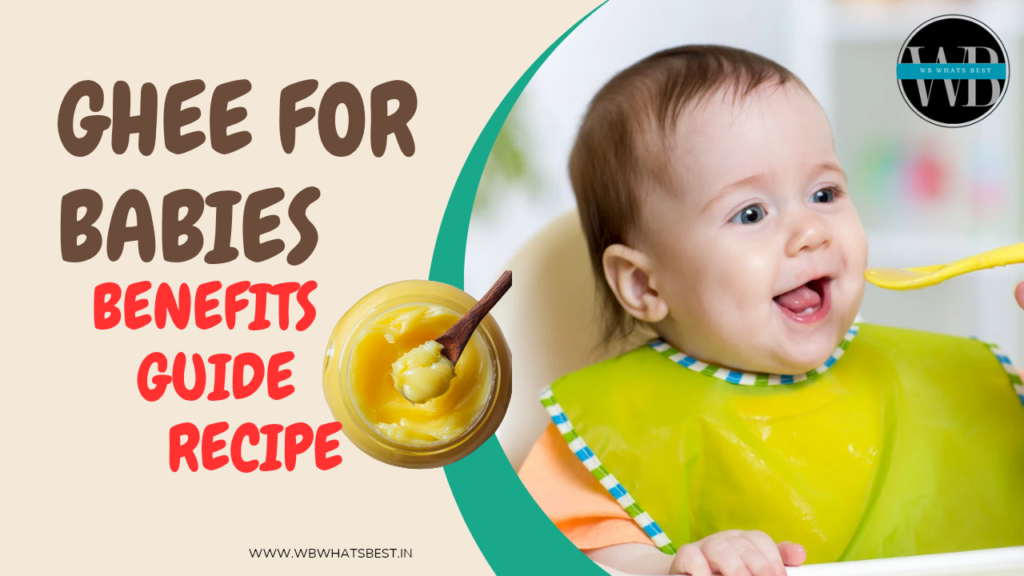Ghee has been a staple in traditional diets for centuries, offering numerous health benefits, especially for growing babies. It is packed with essential nutrients that support digestion, brain development, and overall growth. If you’re wondering whether ghee for babies is a good choice, the answer is a definite yes!

This blog will cover:
✔️ Nutritional benefits of ghee for babies
✔️ Recommended daily intake by age
✔️ Best types of ghee for babies
✔️ Easy homemade ghee recipes
✔️ Ways to introduce ghee into your baby’s diet
Why is Ghee Beneficial for Babies?
Contents
- 0.1 Why is Ghee Beneficial for Babies?
- 0.2 How Much Ghee Should Babies Consume Daily?
- 0.3 Best Ghee for Babies: What to Choose?
- 1 How to Make Ghee for Babies at Home
1. Supports Brain Development
Ghee contains healthy fats, DHA, and omega-3 fatty acids that are essential for brain development. These nutrients aid in memory, learning, and cognitive growth.
2. Aids Digestion and Prevents Constipation
Rich in butyric acid, ghee helps promote gut health, making digestion easier for babies. It also acts as a natural laxative, preventing constipation.
3. Strengthens the Immune System
Loaded with fat-soluble vitamins (A, D, E, and K), ghee helps build immunity, ensuring better resistance against infections and illnesses.
4. Promotes Healthy Weight Gain
If your baby is underweight, adding ghee to their diet can provide healthy calories without putting stress on their digestion.
5. Supports Strong Bones and Muscles
Vitamin D in ghee helps in better calcium absorption, contributing to strong bones and proper muscle development.
6. Provides a Natural Energy Boost
Babies require a steady energy source as they grow, crawl, and explore. Ghee provides quick and sustained energy, keeping them active throughout the day.
7. Nourishes Skin and Hair
Ghee is known for its moisturizing properties. It keeps the skin soft and supple while also strengthening the hair and preventing dryness.
How Much Ghee Should Babies Consume Daily?
The quantity of ghee for babies depends on their age and digestive capacity.
| Baby’s Age | Recommended Ghee Intake per Day |
|---|---|
| 6-8 months | ¼ to ½ teaspoon |
| 9-12 months | ½ to 1 teaspoon |
| 1-2 years | 1 to 1.5 teaspoons |
| 2+ years | 1.5 to 2 teaspoons |
🔹 Introduce ghee gradually, starting with a few drops.
🔹 If your baby has a milk allergy, consult your pediatrician before adding ghee.
Best Ghee for Babies: What to Choose?
✔️ Homemade Ghee – Fresh and free from preservatives.
✔️ Organic A2 Cow Ghee – Made from the milk of grass-fed cows.
✔️ Bilona Method Ghee – A traditionally made ghee that retains maximum nutrients.
If buying ghee, look for organic, grass-fed, and A2 desi cow ghee from reputable brands like:
How to Make Ghee for Babies at Home
Homemade ghee is the purest and safest option for babies. Below are three traditional methods you can use to prepare ghee at home.
1️⃣ Butter Method (Quick and Easy)
Ingredients:
- 500g unsalted cow’s butter (preferably organic)
Steps:
- Place a heavy-bottomed pan on low heat.
- Add the butter and let it melt completely.
- Stir occasionally as the butter starts to foam.
- The milk solids will settle at the bottom while the liquid turns golden.
- Once the ghee becomes clear and aromatic, turn off the heat.
- Strain using a fine sieve or muslin cloth to remove milk solids.
- Store in a clean, dry glass jar.
✔️ Shelf Life: 2-3 months at room temperature.
2️⃣ Malai (Cream) Method (Traditional Method)
This method involves collecting malai (cream) from milk and churning it into butter before making ghee.
Ingredients:
- Full-fat cow’s milk (1 liter or more)
Steps:
- Boil the milk and let it cool down.
- Refrigerate overnight and collect the malai (cream) that forms on top.
- Keep collecting malai for 7-10 days until you have enough.
- Churn the malai using a hand blender or a traditional churner until butter forms.
- Wash the butter with cold water to remove excess buttermilk.
- Heat the butter on a low flame and follow the Butter Method to make ghee.
✔️ Shelf Life: 3-4 months at room temperature.
3️⃣ Curd Method (Bilona Method – Most Nutritious)
This traditional A2 desi cow ghee method is highly nutritious but requires patience.
Ingredients:
- A2 cow’s milk (1-2 liters)
Steps:
- Boil fresh A2 cow’s milk and let it cool slightly.
- Add a spoon of curd and mix well. Leave it to set overnight.
- The next day, churn the curd using a wooden churner (bilona) or hand blender to separate butter.
- Heat the butter on low flame until it turns golden and clear (follow the butter method).
- Strain and store in a glass jar.
✔️ Shelf Life: 4-6 months at room temperature.
How to Introduce Ghee to Babies?
- 6+ months: Add a few drops to mashed vegetables, dal, or khichdi.
- 8+ months: Cook porridge, dosa, or roti with a little ghee.
- 10+ months: Use ghee while making chapatis, parathas, or soups.
- 1 year+: Mix ghee with warm milk or spread on whole wheat toast.
Baby-Friendly Ghee Recipes
✅ Ghee Rice – Add ½ teaspoon of ghee to soft mashed rice.
✅ Dal Khichdi – Cook dal and rice together, then add a spoon of ghee.
✅ Ragi Porridge – Enhance the flavor with a few drops of ghee.
✅ Sweet Potato Mash – Mash boiled sweet potato with ghee for a smooth texture.
Precautions When Giving Ghee to Babies
✔️ Introduce gradually—start with a small quantity and observe.
✔️ Use pure ghee—avoid store-bought ghee with preservatives.
✔️ Watch for allergies—look for signs of bloating, diarrhea, or discomfort.
✔️ Moderation is key—too much ghee can lead to digestive issues.
Other uses of Ghee for Babies
Cow ghee can be used for babies in multiple ways beyond just their diet:
- Massage: Warm a small amount of pure cow ghee and gently massage it onto the baby’s skin to improve hydration, strengthen bones, and promote relaxation. It helps in relieving dryness and soothing rashes.
- Hair Care: Apply a tiny amount of ghee to the baby’s scalp to nourish the hair, prevent dryness, and promote healthy hair growth. Leave it on for a while before washing with a mild baby shampoo.
- Diaper Rash Relief: Cow ghee’s anti-inflammatory properties help soothe diaper rashes and prevent skin irritation. Apply a thin layer on the affected area for relief.
- Cold and Cough Remedy: A drop of warm ghee in the nostrils (for babies above one year) or a gentle chest massage with ghee mixed with a pinch of turmeric can help relieve congestion.
- Lips and Dry Skin: Ghee can be applied to chapped lips, dry cheeks, or elbows to keep the baby’s skin soft and moisturized.
Final Thoughts
Ghee is a superfood for babies, offering a wealth of health benefits. It supports digestion, strengthens immunity, enhances brain development, and provides essential nutrients. The best way to ensure purity is by making homemade ghee using traditional methods.
By including ghee for babies in their diet in the right quantity, you can provide them with the nutrition they need for healthy growth and development.
Would you like more baby food recipes with ghee? Let me know in the comments!
Which ghee is best for babies?
The best ghee for babies is homemade or organic, grass-fed cow ghee, as it is free from additives and rich in healthy fats, essential vitamins (A, D, E, and K), and antioxidants. A2 cow ghee, derived from desi cows, is particularly beneficial due to its easy digestibility and nutritional profile. Always choose ghee that is pure, unsalted, and free from preservatives. When introducing ghee to your baby’s diet, start with a small quantity (around ½ teaspoon) and observe for any allergies or digestive issues.
Is ghee good for babies?
Yes, ghee is good for babies as it is rich in healthy fats, essential vitamins (A, D, E, and K), and antioxidants that support brain development, digestion, and immunity. It also helps in weight gain and provides energy for growing babies. Ghee is easy to digest and can be introduced in small amounts (around ½ teaspoon) after six months of age. However, always use pure, organic, or homemade ghee and consult a pediatrician before introducing it to your baby’s diet.
When to start ghee for babies?
Ghee can be introduced to babies after six months of age, once they start solids. Begin with a small amount (about ½ teaspoon) mixed into mashed foods like dal, khichdi, or porridge. Gradually increase the quantity as the baby grows, but keep it moderate to avoid digestive issues. Always use pure, homemade, or organic ghee and monitor for any allergies or sensitivities. Consult a pediatrician before adding ghee to your baby’s diet.
Which brand ghee is good for babies in india?
Some of the best ghee brands for babies in India include
Vanalaya Organic A2 Desi Gir Cow Ghee
Vedic Ghee Premium A2 Gir Cow Ghee and
Anveshan A2 Cow Ghee
These brands are known for their purity, traditional Bilona preparation method, and high nutritional value, making them suitable for infant consumption. When choosing ghee for babies, opt for A2 cow ghee from organic or grass-fed sources, as it is free from additives and preservatives. Always start with a small amount and consult a pediatrician before introducing it to your baby’s diet.
Cow ghee or buffalo ghee which is better for babies?
Cow ghee is better for babies than buffalo ghee because it is lighter, easier to digest, and rich in essential nutrients like vitamin A, D, E, and K. It contains A2 beta-casein protein, which supports brain development, immunity, and digestion. Buffalo ghee, on the other hand, is heavier, has more fat, and takes longer to digest, making it less suitable for infants. For best results, choose pure, organic, or homemade A2 cow ghee and introduce it in small amounts after six months of age.
